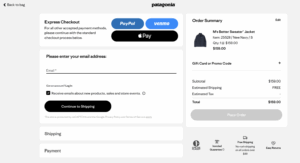Amazon

Amazon’s checkout process is built almost entirely around speed and friction-reduction, enabling massive conversion rates. From the widely reported “One Click” ordering innovation to minimizing the number of steps, Amazon’s UX is tuned to get users from intent to purchase as quickly as possible. There is an option to directly check out a product instead of adding it to the cart, and once the customer is on this page, they are again only one click away from placing the order. The entire process is very easy to navigate and only takes up to seconds. This allows customers to quickly place orders – they can easily buy an item as soon as they’ve identified it.
Warby Parker

The checkout process takes longer for Warby Parker. Users need to pick the lens and provide extensive information about their vision to select the frame and lens. Here, the priority shifts to building customer confidence and reducing hesitation. Their checkout flow carefully removes distractions and retains strong trust signals, minimal form fields, and saved-profile convenience for return customers. That approach supports a higher average order value, since customers feel comfortable making larger purchases once trust is built.
Patagonia

Finally, consider Patagonia: their checkout is part of a broader values-aligned customer-lifetime strategy. The flow supports and reflects their environmental, ethical brand positioning — e.g., repair/resale programs, transparent supply-chain communication — which fosters strong loyalty, repeat purchases and lifetime value rather than immediate impulse conversions. The checkout might allow more reflection or invite commitment, because the customer is buying into a mission as much as a product.
Amazon’s checkout maximizes conversion rate by minimizing friction; Warby Parker’s flow maximizes average order value by instilling confidence and simplifying decision making; Patagonia’s supports customer lifetime value by aligning check-out with a broader brand narrative of values and long-term relationship rather than one-time transactions.
